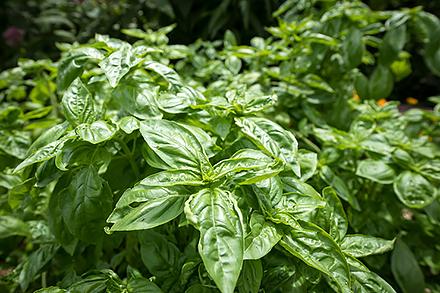The Duke of Herbs (and Medicinal Plants)

Sweet basil. (Photo by Lance Cheung, USDA)
Herbal products are becoming increasingly popular due to the myriad of health benefits that they provide. Many herbs contain antioxidants, compounds that can neutralize free radicals and harmful metabolic byproducts that can damage cells and may lead to diseases such as cancer and Alzheimer's. Along with medicinal and culinary plants, herbs play an important role in almost every facet of our lives, from flavorings and fragrances to medicines and insect repellents. In fact, they have been a part of our lives for centuries.
Indigenous peoples passed down knowledge about collecting and using plants for medicinal purposes for thousands of years. The study of this knowledge, known as ethnobotany, examines the ways in which people of a particular culture collect and use native plants found in their region for food, medicine, clothing, and ceremonial uses. In modern times, alternative healthcare practitioners as well as nutritionists, consumers, and scientists have become interested in this ancient knowledge.
But where can you find reliable information on the medicinal uses of herbs and plants?
One of the most respected resources is Dr. Duke's Phytochemical and Ethnobotanical Databases, created by ARS researcher Dr. James A. Duke. Duke (1929 – 2017), a botanist who traveled the world to study plants, served as chief of the Plant Taxonomy Lab in the ARS Plant Genetics and Germplasm Institute in Beltsville, MD.
After spending several years conducting ecological and ethnobotanical studies while living with various ethnic groups in Panama and Columbia, Dr. Duke joined the ARS in 1971 as an economic botanist at the Germplasm Services Laboratory, where he continued researching crop diversification and medicinal plants in the United States, Central and South America, and several countries in the Middle East, Asia, and Africa. Dr. Duke collected seeds and cuttings from the wild and shared the plant material with researchers, seed banks, and breeders.
"I plug up some of the holes in the germplasm system," he said in a previous interview. "We have curators who collect all the different strains of crops like soybeans and potatoes. But the odd crops—the unusual ones that don't belong anywhere in particular and are maybe on the fringe of the profit margin—that's what I collect."
Over the years, Dr. Duke became an acclaimed expert on herbs and alternative crops, collaborating with the National Cancer Institute to find plants with compounds that might be useful against the AIDS virus and developing several databases cataloging the ecology, nutritional content, chemical constituents, and folk medicinal uses of more than 1,000 species of plants. He also published numerous books including the Peterson Field Guide to Medicinal Plants, Handbook of Legumes of World Economic Importance, and CRC Handbook of Medicinal Herbs.
After his retirement in 1995, Dr. Duke's groundbreaking work was made available online as Dr. Duke's Phytochemical and Ethnobotanical Databases, which are now available for world-wide use through the National Agricultural Library.
Users of the databases can perform plant, chemical, bioactivity, and ethnobotany searches using scientific or common names. Their results might include a list of chemicals and activities for a specific plant of interest, plants with chemicals known for a specific biological activity, plants with potential cancer-preventing activity, or a list of plants for a given ethnobotanical use. Each result also includes references to the supporting scientific publications.
Over the years, Dr. Duke's research and the resulting databases have become some of the world's leading repositories of ethnobotanical data. As such, they remain a powerful tool for pharmaceutical, nutritional, and biomedical researchers, those involved with alternative therapies, and curious members of the public who want to learn more about the myriad of ways that plants can help us. — By Nancy Vanatta, ARS Office of Communications.

